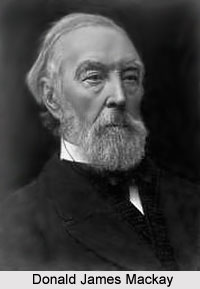 Donald Mackay, officially known as Sir Donald James Mackay, 11th Lord Reay KT, GCSI, GCIE, PC, DL, JP, was appointed as the Governor of Bombay Presidency from the year 1885 to 1890. He was a well known Liberal politician and also one of the renowned a colonial administrators in British India. Donald Mackay was born on 22 December 1839 in The Hague, Netherlands to parents Aeneas Mackay, 10th Lord Reay and Jonkvrouw Maria Catharina Anna Jacoba Fagel, who was the daughter of Jacob Baron Fagel. Mackay succeeded his father as the 11th Lord Reay and became a British citizen in the year 1877. He became Baron Reay, of Durness in the County of Sutherland, in the Peerage of the United Kingdom in the year 1881.
Donald Mackay, officially known as Sir Donald James Mackay, 11th Lord Reay KT, GCSI, GCIE, PC, DL, JP, was appointed as the Governor of Bombay Presidency from the year 1885 to 1890. He was a well known Liberal politician and also one of the renowned a colonial administrators in British India. Donald Mackay was born on 22 December 1839 in The Hague, Netherlands to parents Aeneas Mackay, 10th Lord Reay and Jonkvrouw Maria Catharina Anna Jacoba Fagel, who was the daughter of Jacob Baron Fagel. Mackay succeeded his father as the 11th Lord Reay and became a British citizen in the year 1877. He became Baron Reay, of Durness in the County of Sutherland, in the Peerage of the United Kingdom in the year 1881.
Donald Mackay was appointed as the Governor of Bombay Presidency on 30 March 1885 and was preceded by Sir James Braithwaite Peile, who retired as the Governor of Bombay in 1885. Bombay Presidency was one of the Presidencies and provinces of British India. It was first founded in the 17th century at Surat as a trading post for the British East India Company. The Presidency included the territories of modern states of Gujarat, Maharashtra, regions of Konkan, Kandesh and Desh and northwestern Karnataka state. Sir Donald James Mackay, 11th Lord Reay KT, GCSI, GCIE, PC, DL, JP served in office till 12 April 1890 and was succeeded by Sir George Robert Canning Harris, 4th Baron Harris, GCSI, GCIE.
Donald James Mackay was knighted with Knight Grand Commander of the Most Eminent Order of the Indian Empire in the year 1887 and a Knight Grand Commander of the Most Exalted Order of the Star of India in 1890. He was also made Knight of The Most Ancient and Most Noble Order of the Thistle. After he returned to Britain, Mackay acted as Under Secretary of State for India in Lord Rosebery Liberal administration from 1894 and 1895. He also served as a British delegate at the Second Peace Conference which led to the signing of the Hague Convention 1907.
In the year 1877, Sir Donald James Mackay, 11th Lord Reay KT, GCSI, GCIE, PC, DL, JP was married with married Fanny Georgiana Jane, who was the daughter of Richard Hasler of Aldingbourne in Sussex. The couple did not have any children. Donald Mackay died on 1 August 1921 at the age of 81 years.



















